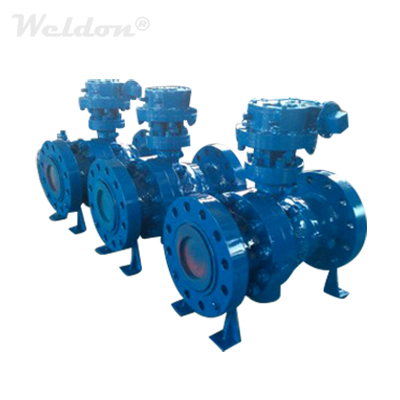What are the technical requirements for valves used for pipelines?
1. Strength and toughness
In addition to bearing the internal medium pressure, the valve still needs to bear the load of the foundation, the axial tension and pressure due to the environmental temperature change, external loads caused by landslides, ground subsidence, and floods. Low-temperature impact toughness needs to be considered in the frigid zone and frozen area to prevent low-temperature brittle fracture. Fracture toughness (CTOD) needs to be considered for fully welded bodies of ball valves, welding seams and heat-affected zones in accordance with the theory of fracture mechanics.
2. Fully sealing requirements
The valve requires fully sealing to ensure effective interception of the downstream pipeline. The metal-to-metal seal is used as the primary seal considering the influence of metal particles in the medium on the fully sealing. PTFE or rubber to metal is used as the secondary seal, and once the seal fails, emergency sealing measures should be taken.
3. Fire safety and anti-static functions
The design of ball valves used for pipelines needs to consider the safety of fire. Once a fire occurs, the external and internal leakage of the valve cannot exceed the leakage standard specified by API 607; the ball is clamped by non-metallic materials, which may generate static electricity, and must be connected to the valve body. Under 24VDC, the resistance value is less than 10 ohms.
4. DBB functions
When the valve cavity is drained, the upstream and downstream valve seats should be automatically closed at the same time to ensure safety during discharge.
5. Preventing clamping of pressure of valve cavities
Prevent the medium from being clamped in the valve cavity, regardless of the valve being in the opening or closing position. If the medium may be clamped, ensure that the pressure in the valve cavity is automatically relieved for gas or liquid. The maximum pressure relief value should not be 1.33 times greater than the valve pressure rating, and the diameter of the external pressure relief valve is DN15 or greater.
6. Draining
The medium in the valve cavity can be drained and the valve can be tested online through the drain hole.
7. Location indicators
There must be an obvious valve indicator indicating the valve’s opening or closing position for both manual or power drive.
8. Driving chain
The design torque of the driving chain should be at least twice the maximum torque of the ball valve.
9. Vulcanization
The pressure-bearing parts and bolt materials should have the ability to resist stress cracking and meet the requirements of NACE and MR0175.
10. Emergency closing functions
The long-distance pipeline transportation system uses a satellite monitoring system (SCADA System). When the pipeline’s pressure drop rate or duration reaches a certain set value, the valve should be closed in an emergency.
11. Considering potential corrosion and stress corrosion of groundwater
Fully welded valve body structure, cathode grounding of pipelines and external surface corrosion are used to prevent potential corrosion and stress corrosion.
Materials of valves used for long-distance pipelines
The selection of materials for long-distance valves used for pipelines should meet the requirements of strength, sealing, service life, high temperature, high pressure, wear resistance, corrosion resistance, fire resistance, and antistatic electricity.
Performance test requirements for valves used for long-distance pipelines
Long-distance pipelines are affected by geographical and natural conditions, and must withstand the effects of changes in climate and temperature, topography and earthquakes. Therefore, the inspection and testing of long-distance valves used for pipelines are more stringent. The shell strength and pressure test, sealing test, action performance test, bending test, tensile test, fire resistance test, durability test, etc. should be carried out. The cold and heat resistance tests should also be performed for some valves. The tested valve should have good sealing performance, flexible operation, accurate action, and good durability. The valve that transports particulate media should also be tested for wear resistance.
 Overview of relevant standards at home and abroad
Overview of relevant standards at home and abroadSome foreign standards
At present, long-distance valves used for pipelines mainly use American Petroleum Institute Standard API 6D Specification of Valve Used for Pipelines and corresponding valve standards, such as API 594 Wafer Check Valves, API 599 Steel and Ductile Iron Plug Valves, API 600 Flanges or Butt Welding Steel Gate Valves for Oil Refinery, API 607 The Fire Resistance Test of Soft Sealed Ball Valves, API 608 Metal Ball Valves with Flange and Butt Welding Ends, API 6FA Specifications of Fire Resistance Tests of Valves, BS 4460 Steel Ball Valves for Petroleum Industry, etc.
The API 6D Specification of Valve Used for Pipelines standard is a standard for comprehensive requirements for manufacturing, inspection and procurement of valves used for pipelines, which indicates the scope of application, connection type, structural length, performance requirements, inspection and testing and marking in detail. The standard content of The API 6D Specification of Valve Used for Pipelines includes nine chapters such as scopes, general rules, materials, valve types and categories, testing, quality control requirements, storage and shipping, etc.
Some domestic standards
The existing domestic standards for long-distance valves used for pipelines include JB/T 5298 Steel Slab Gate Valves for Pipelines and JB/T 7745 Ball Valves Used for Pipelines. Some special valves, for example, emergency shut-off valves have no national or industrial standards. There is no standard specification for valves used for pipelines. Compared with foreign standards, the content of the existing domestic industrial standards is simpler, incomplete, and the requirements are lower.
Next: Setting Pressure of Safety Valves
Previous: Valves Used for Pipelines
